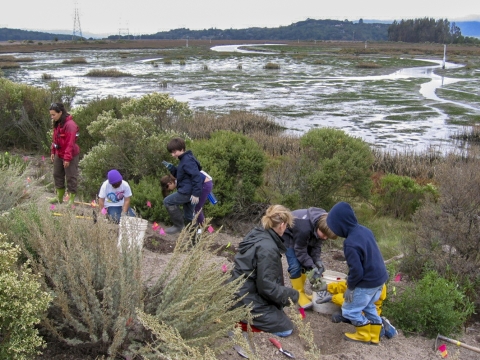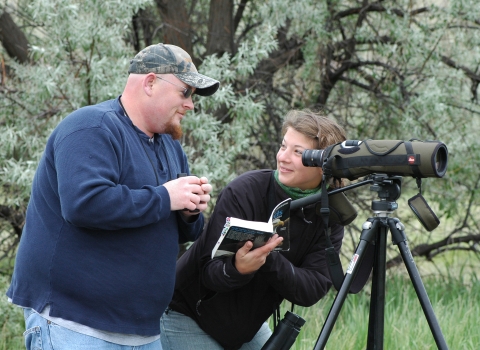Since the 19th century, close to 90 percent of the marshland that historically ringed San Francisco Bay has been lost to development. The effects of that loss include diminished wildlife habitat, increased flood risk, degraded water quality, and far fewer opportunities for nature-based recreation.
In 2016, more than two-thirds of voters across nine counties supported ballot Measure AA, a $12 per year parcel tax over 20 years to provide $500 million in restoration funding to reverse some of those effects.
Now, Measure AA funds administered through the State of California's San Francisco Bay Restoration Authority are funding a range of wetland restoration, flood management and wildlife-oriented public recreation projects are blooming around the Bay, including on the area’s two largest National Wildlife Refuges managed by the U.S. Fish and Wildlife Service.
Almost $8 million granted by the Restoration Authority will enable the historic South Bay Salt Pond Restoration Project, the largest tidal wetland restoration on the west coast, to complete its Phase 2, leveraging state and federal funds to build on the dramatic progress made since the effort broke ground in 2008.
A majority of that $8 million was granted to Ducks Unlimited for restoration of former commercial salt ponds at two locations on the Don Edwards San Francisco Bay National Wildlife Refuge: in Menlo Park, where restoration work on 632 acres will create a mosaic of tidal wetlands, upland transition zone, and managed ponds, providing much-needed habitat for endangered marsh species and migratory birds; and in Alviso, where enhancement of 344 acres of evolving tidal habitat will improve access to bay waters and sediment for two restored ponds, expanding tidal vegetation habitat.
Funds were also allocated to the California Wildlife Foundation for monitoring and study of scientific uncertainties in the large-scale project, to inform future management decisions. Climate change impacts will be reviewed, in addition to options for region-wide sharing of restoration data among land management agencies.
“Funds from Measure AA will allow the South Bay Salt Pond Restoration Project to expand wildlife habitat and public access to open lands, and anchor new water-absorbing marsh while we still have the chance, before rising water levels close that window,” said Anne Morkill, manager of the San Francisco Bay National Wildlife Refuge Complex.
In addition to the salt pond project, Measure AA funds are also contributing to another landmark effort, the South San Francisco Bay Shoreline Project.
Two grants to the Santa Clara Valley Water District totaling $61 million will contribute to the design and construction of an engineered flood protection levee in Alviso, historically prone to flooding. At particular risk is the San Jose-Santa Clara Regional Wastewater Facility, which serves millions of residents in the region. The funds will also enable restoration of 2,900 acres of former salt evaporation ponds on the Don Edwards refuge, and enhance public access to regional trails, wildlife viewing and environmental education. The grants will help the water district meet its cost sharing requirements with the U.S. Army Corps of Engineers, the lead federal agency on the project.
Restoration Authority funds from Measure AA are likewise having a big impact in the North Bay.
Point Blue Conservation Science’s Students and Teachers Restoring a Watershed program received $2.6 million in 2018 to restore 1.3 miles of critical wetland-upland transition habitat, including the San Pablo Bay National Wildlife Refuge. The funding will ultimately engage more than 5,000 students and teachers, over five years, to plant native shrubs, grasses and ground cover, improving wildlife habitats that also serve as buffer zones against rising water levels.
Melissa Pitkin, education and outreach director for Point Blue, described the impact of the program on students: “They love to get dirty and work hard on restoration days. The smiles and joyful shouts outnumber any groans. They take pride in helping their community, and the refuge is a place they can return to over the years to see their work grow and become shelter for birds and other animals.”
Also on the San Pablo Bay refuge, a $150,000 grant to the Sonoma Land Trust is funding a strategy for landscape-scale restoration, flood protection and public access in the Lower Sonoma Creek portion of the San Pablo Baylands. The strategy will ensure that wetland restoration efforts (including the refuge’s recently acquired Skaggs Island) maximize benefits for wildlife habitat and nature-oriented recreation while minimizing the threat of flooding to neighboring properties, roads and rail.
The most recent round of applications for grants from the Restoration Authority closed in December 2019. The next round will be in fall 2020. Approved projects will be submitted to a multi-agency team of staff from six regulatory bodies, including the U.S. Fish and Wildlife Service, for early review and assistance in state and federal permitting.
Morkill says there’s a link between the mandate of the Restoration Authority and the mission of the National Wildlife Refuges that she manages in the Bay Area.
“Restored wetlands not only benefit wildlife, they benefit people, improving water quality and healthy food sources, lowering the risk of flooding, expanding outdoor recreation, and stimulating the local economy. They’re a win in every way.”






